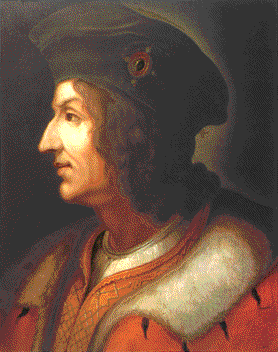‘‘Gran Capitan’’ Gonzalo di Córdoba
Spain’s ‘‘Gran Capitan’’ Gonzalo di Córdoba had been beaten by a Franco-Swiss army at Seminara in 1495. To counter Swiss tactics, at Cerignola he dug a ditch in front of his line. This broke up the cadence of the Swiss pikers, exposing them to murderous Spanish arquebus fire. Once the enemy lines grew ragged Córdoba sent his tercios forward. These were newly reformed units with added pikes and more arquebusiers, which gave the Swiss a taste of their own famous ‘‘push of pike.’’ The Spanish infantry drove the Franco-Swiss troops backward and downslope, while Spanish cavalry pursued and cut down individual soldiers as they ran. The French artillery train was captured. Naples fell to Córdoba on May 13. While the pike remained an integral part of the Spanish tercio, it was the arquebus and musket that gave the formation its power at Cerignola. The battle was the beginning of the end for Swiss infantry dominance.
#
Gonzalo di Córdoba, (1453–1515). ‘‘elGran Capitan.’’
Castilian general who reformed the tercios, reducing reliance on polearms and bringing more guns to reinforced pike formations that could operate independently because of their increased firepower. He fought in Castile’s civil war that attended the ascension of Isabel to the throne. Next, he fought in the long war to conquer Granada, and again against Portugal. He was sent to Naples from 1495 to 1498 to stop the French conquest. He lost to Swiss mercenary infantry at Seminara, but adjusted his strategy and slowly pushed the French out of southern Italy. He used the same tactics in Italy that worked in Granada: progressive erosion of the enemy’s hold over outposts and the countryside, blockading garrisons, and avoiding pitched battles where he could. He fought the Swiss again, and won, at Cerignola (1503), handing them their first battle loss in 200 years. He beat them again that year at their encampment on the Garigliano River. Between fighting the French and Swiss he fought rebellious Moriscos in Granada and against the Ottomans in behalf of Spain and in alliance with Venice. He retired in 1506, well-regarded as a great general of pike and arquebus warfare.
#
Cerignola and Pavia: the matchlock proves its worth
The matchlock was the culmination of two centuries of handgonne development. By the beginning of the 16th century, advances in metallurgy, gunpowder production, and battlefield tactics had created a weapon that could take an equal place among older favourites such as armoured cavalry and infantry pike formations. By this time the old term ‘arquebus’, originally used for some prematchlock handgonnes, had come into common use for matchlocks. Larger specimens were sometimes called ‘muskets’ – the term which would become common with the next generation of longarms. The matchlock had a trigger that released a spring-mounted sear, which dropped the match holder into the priming pan, igniting the priming and the main charge. A button-lock mechanism could also be used. Larger examples were steadied on a forked staff stuck into the ground.
Although it was effective, the matchlock’s rate of fire was slow. Humfrey Barwick, writing in the late 16th century, said an arquebus took 40 seconds to load and fire, and that it had an effective range of 240 yards when fired in volley. He himself could hit a standing man at 120 yards. Other writers claimed a shorter effective range and slower rate of fire, but all agreed that one had to be at close range to pierce armour. However, although it remained slower than the bow, the Graz Armoury tests (detailed on page 70) show that the arquebus had a greatly superior muzzle velocity, and thus penetrative capability, than a bow, crossbow, or early handgonne.
Two 16th-century battles in particular established the matchlock’s reputation as a weapon that could be critical to an army’s victory or defeat. In 1503, the French and the Spanish were fighting for control of southern Italy, and on 28 April the Spanish army under Gran Capitán Gonzalo de Córdoba clashed with the French army of Louis d’Armagnac, Duke of Nemours, at Cerignola. The Spaniards chose to defend a slope in a vineyard, which they augmented with a ditch and earthwork; the ditch strengthened by sharpened stakes. Gonzalo lined his arquebusiers, pikemen, and his small number of cannon behind these defences and awaited the French advance.
The French rashly decided to attack without scouting the Spanish position. They sent in their armoured cavalry, which got stopped short by the ditch and gunned down by the arquebusiers. The Duke of Nemours was among those slain. A second wave, composed of Swiss mercenary pikemen, came under heavy fire as they tried to cross the ditch and earthwork. A Spanish counterattack of infantry carrying swords and bucklers (small shields) rushed into the broken lines and slaughtered the Swiss, whose pikes were useless at such close quarters. The survivors fled in disorder and the Spanish captured their artillery train and much of their baggage. Gonzalo’s wise use of terrain to maximize the effectiveness of his arquebusiers won the day. The slaughter at Cerignola left at least 3,000 dead on the French side, while the Spaniards suffered barely a hundred casualties.
